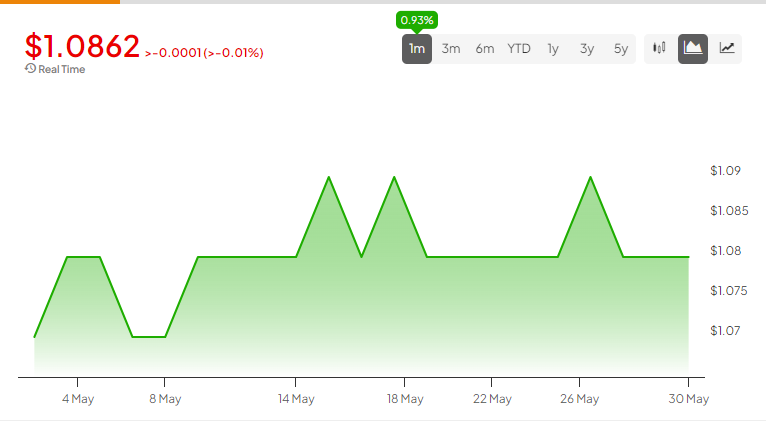From steady climbs to sharp drops, May was anything but boring for EUR-USD. From inflation woes to unemployment rates, the currency pair’s value was a dance of economic indicators and market sentiment. Here’s how it unfolded:
Claim 70% Off TipRanks This Holiday Season
- Unlock hedge-fund level data and powerful investing tools for smarter, sharper decisions
- Stay ahead of the market with the latest news and analysis and maximize your portfolio's potential
Early Gains and Mid-Month Volatility
The month kicked off with a steady climb. By May 2, EUR-USD sat at 1.0725, reflecting a modest 0.15% rise from the previous day. This came on the back of positive sentiments as traders digested the latest comments from Fed officials who, despite acknowledging persistent inflation, assured that monetary policies were on track to tame it.
But stability was a luxury the market couldn’t afford. By May 8, the pair fell to 1.0745, a 0.07% dip. The slight decline was a reaction to mixed signals from the Fed and a marginally lower-than-expected preliminary CPI reading from Spain. As May progressed, the pair continued its unpredictable journey. On May 15, a surprising 0.59% surge pushed the EUR-USD to 1.0882. This spike aligned with a slew of optimistic reports, including a decrease in the Eurozone’s unemployment rate to 6.4%, a notch below the expected 6.5%.
A Dive Towards Month-End
However, the EUR-USD didn’t keep the bullish momentum. The tail end of May was particularly harsh, with the currency pair dropping to 1.0800 by May 29, a significant 0.51% decline from the previous day.

This drop coincided with a wave of dollar strength spurred by Deutsche Bank’s predictions of dollar selling towards the month-end and former NY Fed President Dudley’s criticism of the FOMC’s efforts against inflation. The situation wasn’t helped by the European Central Bank’s comments about potential disruptions in inflation expectations due to energy price shocks.
By May 31, EUR-USD closed at 1.0819, a slight 0.12% drop, rounding off a month characterized by volatility. Panetta, one of the European Central Bank’s officials, offered some reassurance with talks on economic policies, but concerns about inflation and employment remained dominant themes. Here are some key points to consider:
- Spain’s Preliminary CPI (May): 3.6% (versus 3.7% expected) – Minor inflation relief but still a concern.
- Eurozone Unemployment Rate (April): 6.4% (better than 6.5% expected) – Slight improvement signaling labor market resilience.
- Eurozone Consumer Confidence (May): -14.3 (unchanged from preliminary) – Reflecting ongoing cautious optimism.
The outlook for EUR-USD remains clouded by uncertainty. The Fed’s stance on interest rates and the ECB’s efforts to combat inflation will be pivotal. With experts like Fed’s Williams and Bostic ruling out immediate rate cuts and others like Logan wary of energy price shocks, traders should brace for more fluctuations.
Is the EUR-USD a Buy?
According to TipRanks’ Summary of Technical Indicators, EUR-USD is a Buy.

















